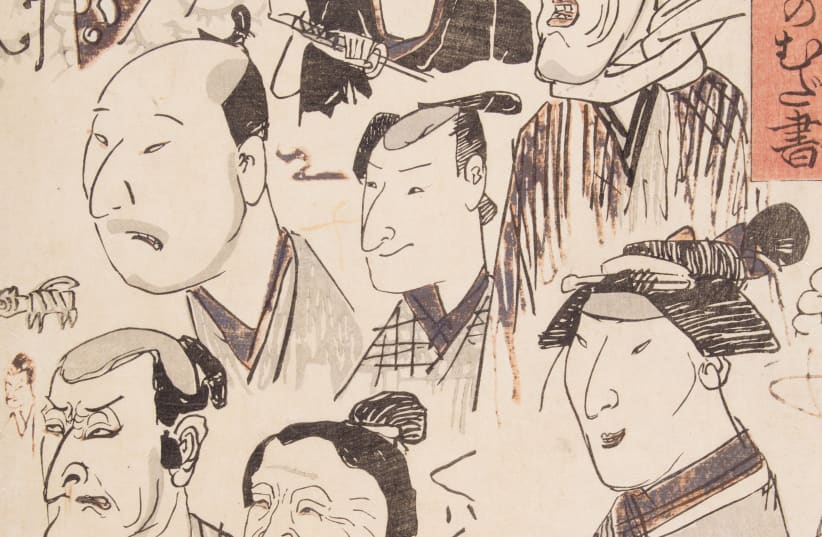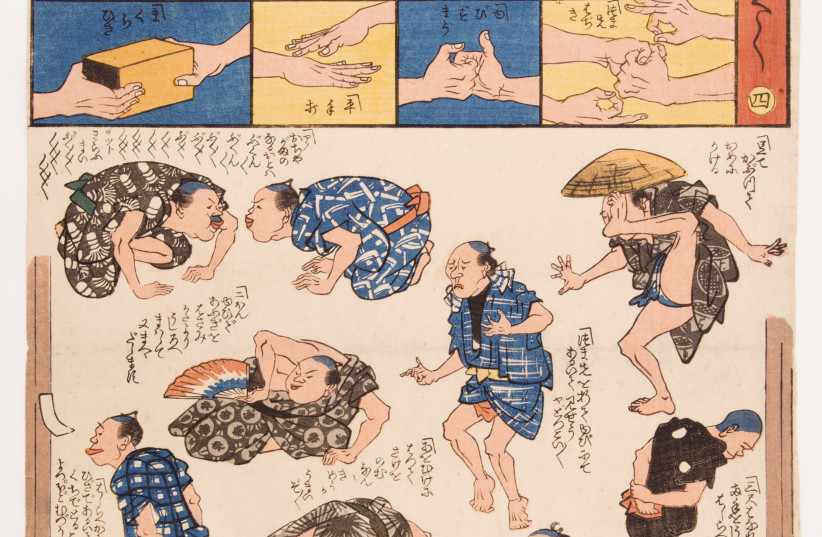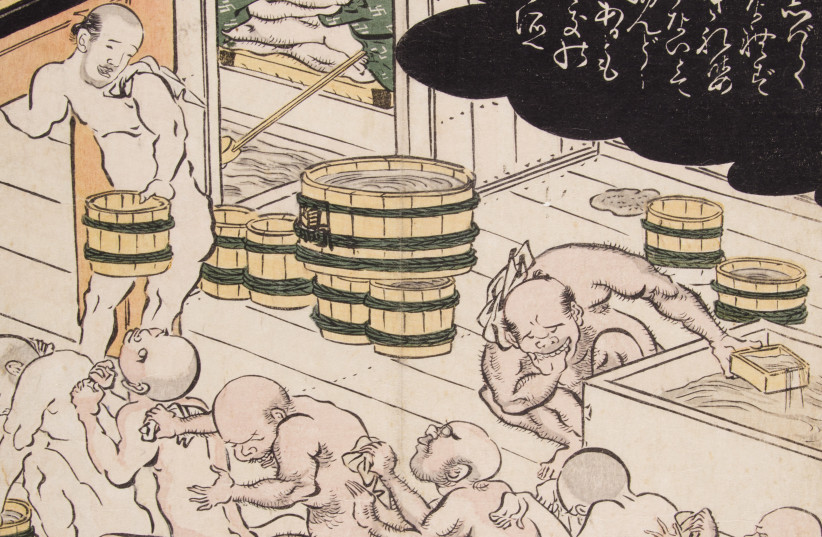Japanese 19th-century woodblock prints show life in a dreamy bygone era. Still, the thrill of seeing the hand-colored, hand-carved illustrations in Pulling Faces, an exhibition now on display at Haifa’s Tikotin Japanese Museum of Art, is that some of the simple pleasures depicted in these woodblock prints still endure in Japan to this day.
With masks covering us up for the past two years, we’ve almost forgotten what it feels like to undress our faces and show off the multitude of expressions of our lovely partzufim (visages). The Pulling Faces exhibition reminds us how good it feels to experience each other through the facial expressions we make, a divine pleasure that comes from scrutinizing all the nifty things a face can do and a mask simply cannot.
Japanese sense of humor tends toward the silly, the light-hearted and the downright bawdy, and Pulling Faces doesn’t disappoint. The show offers about 20 woodblock prints by three of the renowned Utagawa school’s greatest artists – Toyokuni (1976-1825), Hiroshige (1797-1858) and Kuniyoshi (1797-1861), each in their signature styles.
“They all belonged to the same Utagawa school of wood carving,” explains Tikotin Museum curator Dr. Etty Glass Gissis. “They belonged to the same social circle and responded to each other’s works. They were making a statement by identifying with the common man and popular culture.”
Also known as Ukiyo-e, this era of woodblock prints focused on the ordinary things in life. The Utagawa woodblock artist’s love for facial exaggeration is one of Pulling Faces’ highlights. In enhancing the drunkenness of an outdoor party of revelers, or the ecstasy in the smile of blind men receiving back rubs in the bathhouse, these everyday scenes hint at one of Japan’s best-kept secrets: that these activities still exist in contemporary Japan – if you scout for them.
In Hiroshige’s woodblock print, a scene from the masterpiece, Fifty-three Stations of the Tokaido, the artist depicts a pilgrim carrying 55 copies of the Lotus Sutra, the main scripture upon which Buddhism was established. Surprisingly, Hiroshige chooses to connect spirituality with a lively scene of relaxation on the long Tokaido road out of Tokyo. They’re holding in their hands the same onigiri rice balls that you can purchase today in any convenience store in Japan. Unmasked, they look more animal-like than human, which Hiroshige may have intended, as he was fond of depicting animals in his art.
In another scene by Hiroshige, a caricature of four courtesans with tobacco implements, women sing with abandon, hilariously so. Today, you can see these gaping-mouth singers standing alone or with friends at karaoke parlors almost everywhere in Japan.
Then there’s sumo wrestling, a sacred reenactment of a game that is still attended on occasion by the emperor, in whose name the Emperor’s Trophy was received by the grand champion, called the yokozuna. In sumo, two strong men face off against each other within the confines of a small sand-dirt ring. The objective is to push and shove the opponent out of the ring. Here in Comic Faces and Foolish Tricks, Hiroshige entertains us with what could be a parody of Japan’s sacred sport. We see how strength emanates not just from brawn, but from fierceness in the eyebrows and narrowing eyes and impossible backbends.
Sophiya Gugelev, a Haifa-based Japanologist, notes that the greatest artists in the Utagawa School “had a brilliance to recognize and depict human psychology.”
And while the era of the great woodblock print artists has long passed, the Japanese contribution to celebrating facial expressions continues to have an impact to this day. In 1999 along came Japanese digital genius and artistic pioneer Shigetaka Kurita. He was 25 when he invented the perky little yellow emoji symbols that punctuate most everything these days and unwittingly created a universal language without words.
I have to admit that I’m impartial to bathhouse scenes, like you see in Hiroshige’s woodblock print. Bathhouses used to be commonplace in Tokyo, where it wasn’t that many years ago that the older folks would end their day in the company of naked friends. They’d sit in a boiling hot bath in a mosaic-tiled bathhouse decorated with a scene of Mount Fuji.
I know because I spent 30 years in Japan, and remember well those moments of par-boiling in the bathhouse to the laughter of the locals, who thought it hilarious to see a foreign newcomer recoil at the prospect of turning red as a crab.
Today, to experience this scene right out of a woodblock print, you need go no further than Hakone’s hot spring (onsen) resort area, a mountainous, lush green playground of hotels specializing in spas where you can glimpse the same views of Mount Fuji from which the Utagawa woodblock artists took their inspiration.
The long chain of men massaging each others’ backs may belong to Hiroshige’s time. Still, that look of bliss is hilariously authentic today – whether you enter through the typically red curtain that leads to the woman’s entrance or the blue curtain to the men’s quarter.
In the Hiroshige scene of the four courtesans with tobacco implements, I can’t help but chuckle at the way they sing with their mouths wide open to heart’s abandon, no doubt with throats well lubricated by sake or beer.
It reminds me of a time long ago when I was newly married in Tokyo. My new husband had a grueling work schedule, permitted one Sunday off every six weeks, a rite of passage for training seriously in Oriental medicine.
Quite suddenly, the master of the clinic would announce that he’d be taking us all – the entire staff and their families – far into the countryside for a break. There, we would hole up in extravagantly beautiful hot spring hotels and engage in just the activities depicted in these woodblock prints. The joy and abandonment would remove the steam we all felt from the pressure-cooker life in Tokyo.
The Tikotin Museum shows woodblocks from its vast collection throughout the year, so if you miss this show, view the woodblocks online or visit this gem of a museum in Haifa and meet the timeless faces of Japan spanning the centuries. ■
***
The current headline exhibition at the Tikotin Museum features the art and sculptures of Yasuhiro Suzuki, whose colorless and translucent show, at first glance, almost disappears from the walls when seen after the Pulling Faces exhibition. This is why it was a good idea to put the woodblock prints in a gallery tucked behind the Suzuki show.
Step forward into the stark white space and peer closely to take in a 21st-century Japanese artist’s sense of humor in a solo show called Blinking. He takes unrelated items, like an eye and a leaf, chopsticks and toes, and makes mind-bending connections between them. Suzuki is at his best in the invention of facial expression in a clock with eyes that operates by blinking.
For more information on the Tikotin Museum: www.tmja.org.il/eng/
The writer is the author of the memoir, The Wagamama Bride: A Jewish Family Saga Made in Japan.


